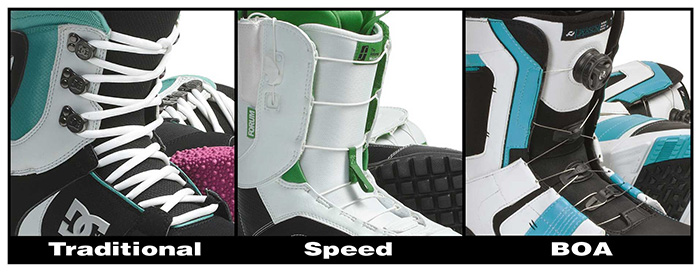
-

Snowboard boot flex relates to the stiffness or softness of a pair of boots. Stiffer boots offer more support and response at high speeds, which is great for aggressive carving. Softer boots provide slightly less stability, but make performing tricks and jumps in the terrain park more comfortable. Riders who enjoy both carving and occasional freestyle often prefer medium flex.
There’s no industry standard for measuring boot flex, and most snowboarding brands use their own system. For example, one brand may call a pair of boots “medium-stiff.” Some brands like Ride Snowboards use a numeric flex scale of 1 to 10, with 1 being the softest and 10 being the stiffest. To determine what boot flex will work for your riding style, the chart below is a good starting point.
Riding Style Recommended Flex Recommended Flex (Numeric) Freestyle Soft 1-4 All-Mountain Medium 5-7 Freeride/Backcountry Medium to Stiff 5-10 Race/Freecarve Stiff 7-10 -
The three most common types of boot lacing systems are traditional lacing, speed lacing and BOA®. More advanced lacing systems can make getting in and out of your boots much easier, but usually increase cost. If you only plan to ride a few times a year, a pair of entry-level snowboard boots with traditional lacing should be adequate. If you ride often or own a season pass, you’ll probably enjoy having a pair of boots with a quick-pull lacing or a BOA® system.

Traditional Laces
Regular laces are the least expensive option. Although it can take more time to achieve an ideal fit with laces, they are easy and inexpensive to replace if they get worn out or break. Some riders use a customized lacing technique to achieve a better fit.
Speed Lacing
Speed lacing, sometimes called quick-pull lacing, uses a thin, high-strength cord that passes through a series of smooth grommets and channels. Pulling firmly on the cord cinches the entire boot snuggly, and a lace lock at the top maintains tension. When it’s time to take off or loosen your boots, simply disengage the lock. This system makes getting in and out of your boots extremely quick and convenient.
BOA® System
The BOA® system works very similarly to a quick-pull system, except a thin, high-tensile metal cable is used in place of a cord. Also, instead of a cord lock, tension is created with a ratcheting dial mounted on the front or side of the boot. Twisting the dial increases tension to snug the boot. Pulling on the knob releases the internal mechanism, relieving tension. Some BOA® snowboard boots feature two dials with upper and lower compression zones, allowing each to be adjusted independently for a customized fit. DC Shoes, Ride, Vans, K2 and several other brands offer snowboard boots with the BOA® System.
-
Snowboard boot liners keep your feet supported, warm and comfortable during a long day on the slopes. Many snowboard boot liners have some type of quick-pull lacing that allows you to snug them independently from the exterior of the boots. Some boots even use a second BOA® system to tighten the liner. Moldable liners will conform to a rider’s individual foot and leg shape as they warm from body heat. Keep an eye out for other beneficial features, like instep padding for added comfort, shock-absorbing EVA footbeds and antimicrobial treatment to fight odors.
Tip: The liner of most snowboard boots is removable, and it’s always a good idea to remove the liner after a day of riding. This will allow the liner and the interior of the boot to dry faster and potentially prevent bacteria, fungus and odor from taking hold, or at least minimize it.
-

Don't Automatically Size Up
Most snowboard boots are designed to fit accurately according to your normal shoe size. In other words, if you wear a men’s size 10 shoe, a men’s size 10 snowboard boot should fit properly. Unless the product page recommends ordering a half or full size larger, consider ordering your normal size first.
Leave a Little Room in the Toe Box
For an ideal fit, there should be a very small amount of space between your toes and the toe cap of your boots. It’s okay if your toes occasionally brush the front of the boot, as long as they aren’t pressed up against it. However, if there is too much room in the toe box, your heel may slide forward and cause uncomfortable heel lift.
Be Aware of Break-In Time
Like other boots, snowboard boots require a little break-in time. A new pair of boots should feel snug on your lower leg and foot, but not to the point that they restrict blood flow. As you wear them, the padding inside will compress slightly, giving you a little more room. If your new boots feel roomy out of the box, they may become too loose after breaking them in. To help speed the break-in process before a trip, wear your boots around the house for a few hours.
Wear Snowboard Socks
Wearing snowboard socks or ski socks that fit over the lower calf can really make a difference in your comfort level. Designed to offer a combination of warmth, moisture-wicking performance and cushioning, snowboard socks will keep your toes toasty and provide a little extra cushion for your shins. If you’re trying on snowboard boots in a store, take a pair of snowboard socks with you. Also, one pair of socks will do on the slopes. If your boots fit properly, you should only need a single pair to keep your feet warm.